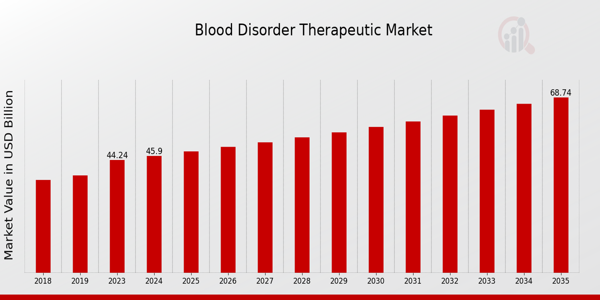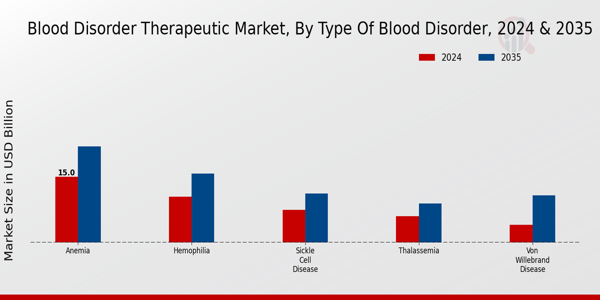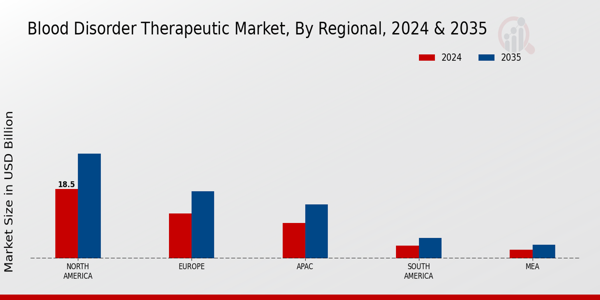Blood Disorder Therapeutic Market Overview
As per MRFR analysis, the Blood Disorder Therapeutic Market Size was estimated at 44.24 (USD Billion) in 2023. The Blood Disorder Therapeutic Market Industry is expected to grow from 45.9(USD Billion) in 2024 to 68.7 (USD Billion) by 2035. The Blood Disorder Therapeutic Market CAGR (growth rate) is expected to be around 3.74% during the forecast period (2025 - 2035).
Key Blood Disorder Therapeutic Market Trends Highlighted
The Global Blood Disorder Therapeutic Market is experiencing significant growth driven by an increasing prevalence of blood disorders such as anemia, hemophilia, and sickle cell disease. Advances in research and development have led to novel therapies that target specific conditions with greater efficacy and fewer side effects. This growth is further supported by an aging population that is more susceptible to these disorders. Additionally, heightened awareness of the need for effective treatment options in developing regions has led to a greater focus on creating affordable therapies, thus expanding market potential. Opportunities in this market are abundant, particularly in the realm of personalized medicine and gene therapy.With the comprehension of genetic disorders getting better, there is a movement toward creating customized therapies aimed at specific patients.
This is important as it may open ways to treat or effectively manage blood disorders that have refrained from conventional treatment methodologies. Partnerships between biotech companies and traditional pharmaceutical companies are also ushering new therapies into the market. On top of this, the gradually increasing openness to new treatment strategies provides even more avenues for market penetration. A more recent development that has gained more attention is the focus on the use of targeted biologics and monoclonal antibodies, where side effects are targeted to be less while effectiveness is maximized.
Increased investment in clinical trials for novel therapies is paving the way for advancements in treatment options. Digital health solutions, such as telemedicine and portable diagnostic tools, are also emerging, improving patient access to care and monitoring. As more stakeholders recognize the importance of addressing blood disorders, the market is becoming increasingly dynamic, adapting to the evolving healthcare landscape while striving to improve patient outcomes.

Source: Primary Research, Secondary Research, MRFR Database and Analyst Review
Blood Disorder Therapeutic Market Drivers
Increasing Prevalence of Blood Disorders
The Global Blood Disorder Therapeutic Market industry is witnessing significant growth due to the increasing prevalence of various blood disorders such as hemophilia, sickle cell anemia, thalassemia, and other related conditions. This rise in cases can be attributed to genetic factors, lifestyle changes, and environmental influences that contribute to the incidence of these disorders. As the number of diagnosed patients continues to rise globally, there is an increased demand for effective treatment options.Given that in 2024, the market is expected to reflect a considerable valuation, pharmaceutical firms and researchers are focusing on developing innovative therapies, including gene therapies and novel pharmaceuticals.
The growing awareness and understanding of these disorders in both developed and developing nations are leading to early diagnosis and treatment. This trend indicates a strong future demand in the Global Blood Disorder Therapeutic Market industry, highlighting the essential need for ongoing research and development, which provides hope for improved patient outcomes over the years.The increasing emphasis on personalized medicine and targeted therapies further drives innovation, making it essential to cater to various patient needs and preferences across different demographics. The healthcare sector is expected to adapt to these changing trends, offering not only conventional therapies but also state-of-the-art treatments aimed at addressing the unique genetic profile of patients with blood disorders.
Advancements in Treatment Technologies
The advancements in treatment technologies are propelling the growth of the Global Blood Disorder Therapeutic Market industry. Innovative approaches in pharmaceuticals and biotechnology have led to the development of more effective therapies, including monoclonal antibodies and advanced gene therapies. Furthermore, technological progress in diagnostics improves the identification of blood disorders, thus aiding in the timely intervention and management of these conditions.The integration of cutting-edge research is vital as it facilitates the creation of superior treatment modalities that enhance patient quality of life, affirming the market’s positive trajectory.
Rising Awareness Campaigns and Healthcare Initiatives
The rise in awareness campaigns and healthcare initiatives focused on blood disorders is another crucial driver for the Global Blood Disorder Therapeutic Market industry. Various organizations and healthcare institutions are actively promoting understanding of blood disorders among the general public, leading to increased screening and early detection. As awareness grows, more individuals seek medical advice and undergo diagnostic testing, directly affecting the demand for blood disorder therapeutics.Success in these initiatives highlights the pressing need for enhanced treatment options and access to therapies.
Blood Disorder Therapeutic Market Segment Insights
Blood Disorder Therapeutic Market Type of Blood Disorder Insights
The Global Blood Disorder Therapeutic Market is categorized into various types of blood disorders, playing a significant role in shaping the overall industry dynamics. In 2024, the market is set to reach a valuation of 45.9 USD Billion, demonstrating the increasing importance of addressing these health conditions. Anemia holds a majority position within this segment, with a market value of 15.0 USD Billion, which is expected to elevate to 22.0 USD Billion by 2035, attributable to its high prevalence across the globe. Following closely is Hemophilia, valued at 10.5 USD Billion in 2024 and anticipated to grow to 15.8 USD Billion, showing its significant impact on the therapeutic landscape associated with bleeding disorders.Sickle Cell Disease represents another crucial area within the market, starting at 7.4 USD Billion in 2024 and projected to reach 11.2 USD Billion as research and treatment options improve.
Thalassemia remains a vital segment, valued at 6.0 USD Billion in 2024 and aimed at reaching 8.9 USD Billion by 2035. This particular disorder is especially relevant in certain geographical regions, making advancements in treatment essential. Lastly, Von Willebrand Disease, while smaller in market valuation at 4.0 USD Billion in 2024, is expected to see substantial growth, reaching 10.8 USD Billion, highlighting the continued need for innovations and therapies.Collectively, these blood disorders contribute to the overall growth of the Global Blood Disorder Therapeutic Market revenue by addressing significant healthcare needs, forming a critical foundation to understand market segmentation and further uncovering opportunities within the industry.
The increasing prevalence of these disorders, along with advancements in treatment options, will influence Global Blood Disorder Therapeutic Market statistics and reshape the future landscape of therapies available to patients globally. As healthcare providers and researchers focus on developing effective solutions for these disorders, the market growth trajectory remains promising.Enhanced awareness, evolving technology, and increased funding for research into blood disorders are vital components driving the ongoing progress within the Global Blood Disorder Therapeutic Market data, aiming to enhance the quality of life for those affected by these conditions. The segment of Type of Blood Disorder not only showcases the importance of specialized therapy but also highlights opportunities for significantly enhancing treatment strategies, ultimately paving the way for sustained market evolution.

Source: Primary Research, Secondary Research, MRFR Database and Analyst Review
Blood Disorder Therapeutic Market Drug Class Insights
The Global Blood Disorder Therapeutic Market is projected to reach a market value of 45.9 billion USD by 2024, reflecting substantial growth influenced by various drug classes. The market segmentation reveals critical areas such as Blood Transfusion Products and Coagulation Factor Concentrates, which play vital roles in the management of blood disorders. Blood Transfusion Products are essential for patients suffering from anemia or requiring surgery, while Coagulation Factor Concentrates are crucial for treating hemophilia and other bleeding disorders.Erythropoiesis-Stimulating Agents significantly aid in addressing anemia related to chronic illnesses, enhancing patient outcomes. Moreover, Platelet Aggregation Inhibitors and Anticoagulants are increasingly important as they help manage and prevent thromboembolic disorders, addressing the rising concerns related to cardiovascular health. These segments not only dominate the Global Blood Disorder Therapeutic Market statistics, but they also reflect the industry's response to evolving medical needs and the ongoing trends toward personalized medicine.Factors such as technological advancements and increasing awareness about blood disorders are expected to drive market growth while presenting numerous opportunities for innovation within these drug classes.
Blood Disorder Therapeutic Market Route of Administration Insights
The Global Blood Disorder Therapeutic Market, valued at approximately 45.9 USD Billion in 2024, showcases a diversified approach in its Route of Administration segment essential for effective treatment strategies. Among these methods, Intravenous administration plays a critical role in ensuring rapid absorption of therapeutics directly into the bloodstream, benefiting patients who require immediate intervention. Additionally, Subcutaneous administration is gaining traction due to its convenience and ease of use, offering patients the ability to self-administer treatments at home, thus enhancing adherence to prescribed regimens.Oral administration remains a staple due to its non-invasive nature, making it preferable for long-term treatment scenarios, especially among pediatric and geriatric populations. Furthermore, Intramuscular administration is significant for delivering certain biopharmaceuticals that require gradual absorption. This Route of Administration segment is driven by the increasing prevalence of blood disorders and the ongoing research and development efforts that aim to enhance drug delivery systems, aligning with the larger trends in the Global Blood Disorder Therapeutic Market industry.The growth within this segment highlights opportunities for innovative therapeutic solutions and a robust framework for addressing treatment efficacy and patient compliance.
Blood Disorder Therapeutic Market End User Insights
The Global Blood Disorder Therapeutic Market is a crucial sector projected to reach a valuation of 45.9 USD Billion by 2024. Within this market, the End User segmentation plays a pivotal role, encompassing various healthcare settings. Hospitals are significant players due to their comprehensive resources and specialized staff necessary for the treatment of blood disorders. Homecare, gaining traction recently, offers patients convenience and personalized care, enabling better disease management. Specialty clinics also represent an essential segment, as they provide focused and expert treatment options that cater specifically to blood disorders.Blood banks are vital in this ecosystem, as they ensure the availability and safety of blood products, crucial for therapies. Overall, the Global Blood Disorder Therapeutic Market data indicates that these sectors work synergistically, highlighting the importance of comprehensive treatment approaches across multiple healthcare environments while dealing with challenges such as resource allocation and technological advancements in treatment methodologies. As the market continues to evolve, opportunities for enhanced patient care methods and innovative treatment solutions emerge, contributing to the projected growth in the upcoming years.
Blood Disorder Therapeutic Market Regional Insights
The Global Blood Disorder Therapeutic Market is poised for substantial growth across various regions, with North America leading the charge. In 2024, North America is valued at 18.5 USD Billion, reflecting a majority holding in the market due to its advanced healthcare infrastructure and high prevalence of blood disorders. Europe follows with a valuation of 12.0 USD Billion in 2024, showcasing its significant role propelled by substantial investments in research and development. The APAC region holds a valuation of 9.5 USD Billion, which is also noteworthy as it is experiencing rapid economic growth and increasing healthcare access, making it a vital emerging market.In South America, the market is valued at 3.5 USD Billion, indicating potential for growth, especially given the rising awareness of blood disorders in this region. The MEA segment, with a valuation of 2.4 USD Billion, represents the smallest market share; however, it presents opportunities for expansion as healthcare systems develop. Overall, the Global Blood Disorder Therapeutic Market segmentation reveals diverse opportunities and growth potential across these regions, driven by varying healthcare advancements and increasing disease awareness.

Source: Primary Research, Secondary Research, MRFR Database and Analyst Review
Blood Disorder Therapeutic Market Key Players and Competitive Insights:
The Global Blood Disorder Therapeutic Market is characterized by an intricate landscape shaped by various competitive dynamics. The market comprises a wide range of therapies designed for conditions such as anemia, hemophilia treatment, sickle cell disease, and other hemoglobinopathies. With the increasing prevalence of blood disorders due to genetic factors, lifestyle choices, and environmental influences, there has been a pronounced demand for innovative treatment modalities. The competitive environment is marked by extensive research and development activities, strategic collaborations, and significant investments aimed at discovering and commercializing novel therapeutics. Key players are engaged in the continual refinement of treatment regimens, focusing on enhancing patient outcomes while navigating regulatory frameworks and reimbursement challenges.
The complexity of blood disorders further propels competition as companies strive to differentiate their products through efficacy, safety profiles, and delivery methods. Celgene has established a formidable presence within the Global Blood Disorder Therapeutic Market, specializing in the development of targeted therapies and advanced biologics. The company’s robust pipeline is complemented by its commitment to innovation, with multiple candidate drugs showing promise in clinical trials specifically for blood disorders. Celgene's strengths lie in its extensive expertise in hematology-oncology, leading to the development of therapies that address unmet medical needs in blood disorders. The company leverages strong research capabilities and strategic partnerships, allowing it to maintain a competitive edge by accelerating the development and commercialization of novel therapeutics. Additionally, Celgene's focus on patient-centric solutions and collaboration with healthcare professionals enhances its reputation and market positioning within the sector. Bristol-Myers Squibb has made significant strides within the Global Blood Disorder
Therapeutic Market, characterized by its strong portfolio of treatment options for patients suffering from a variety of hematologic conditions. The company is known for its commitment to research and innovation in developing biological and small molecule therapies that target blood disorders effectively. Bristol-Myers Squibb’s strengths include its strategic acquisitions which have broadened its therapeutic offerings, coupled with a robust development pipeline aimed at addressing both prevalent and rare blood disorders. The company’s extensive clinical research capabilities, along with its seasoned workforce, enable it to remain at the forefront of advancements in the therapeutic landscape. Furthermore, the collaboration between Bristol-Myers Squibb and various academic institutions and research organizations amplifies its potential to leverage cutting-edge science in producing next-generation therapies tailored to patient needs.
Key Companies in the Blood Disorder Therapeutic Market Include:
- Celgene
- Bristol-Myers Squibb
- Roche
- Novartis
- Sanofi
- Vertex Pharmaceuticals
- Bluebird Bio
- Pfizer
- AstraZeneca
- Gilead Sciences
- AbbVie
- Takeda
- Amgen
- Bayer
- Johnson and Johnson
Blood Disorder Therapeutic Market Industry Developments
Recent developments in the Global Blood Disorder Therapeutic Market reflect significant advancements and strategic movements among leading companies. Celgene and Bristol-Myers Squibb continue to enhance their portfolios with innovative therapies aimed at multiple myeloma and other blood disorders. Roche and Novartis are both advancing their clinical trials for hemophilia treatments, indicating a strong focus on rare blood disorders. Sanofi and Vertex Pharmaceuticals are collaborating to bring new gene therapies to market, with an emphasis on improving patient outcomes for those with sickle cell disease.
Bluebird Bio is making strides in developing gene therapies specifically targeted at beta-thalassemia, showcasing the growing trend of genetic solutions. Recent acquisitions in the sector include Pfizer's purchase of various biotech assets to bolster its hematology pipeline, while AstraZeneca’s strategic partnerships are aimed at expanding its presence in the blood disorder therapeutics space. Gilead Sciences is also exploring potential mergers to enhance its onco-hematology portfolio. These activities contribute to a dynamic and evolving market landscape, underscored by robust growth in valuations as companies invest in cutting-edge treatments to meet the rising demand for effective blood disorder therapies.
Blood Disorder Therapeutic Market Segmentation Insights
Blood Disorder Therapeutic Market Type of Blood Disorder Outlook
- Anemia
- Hemophilia
- Sickle Cell Disease
- Thalassemia
- Von Willebrand Disease
Blood Disorder Therapeutic Market Drug Class Outlook
- Blood Transfusion Products
- Coagulation Factor Concentrates
- Erythropoiesis-Stimulating Agents
- Platelet Aggregation Inhibitors
- Anticoagulants
Blood Disorder Therapeutic Market Route of Administration Outlook
- Intravenous
- Subcutaneous
- Oral
- Intramuscular
Blood Disorder Therapeutic Market End User Outlook
- Hospitals
- Homecare
- Specialty Clinics
- Blood Banks
Blood Disorder Therapeutic Market Regional Outlook
- North America
- Europe
- South America
- Asia Pacific
- Middle East and Africa
| Attribute/Metric Source: |
Details |
| MARKET SIZE 2023 |
44.24(USD Billion) |
| MARKET SIZE 2024 |
45.9(USD Billion) |
| MARKET SIZE 2035 |
68.7(USD Billion) |
| COMPOUND ANNUAL GROWTH RATE (CAGR) |
3.74% (2025 - 2035) |
| REPORT COVERAGE |
Revenue Forecast, Competitive Landscape, Growth Factors, and Trends |
| BASE YEAR |
2024 |
| MARKET FORECAST PERIOD |
2025 - 2035 |
| HISTORICAL DATA |
2019 - 2024 |
| MARKET FORECAST UNITS |
USD Billion |
| KEY COMPANIES PROFILED |
Celgene, BristolMyers Squibb, Roche, Novartis, Sanofi, Vertex Pharmaceuticals, Bluebird Bio, Pfizer, AstraZeneca, Gilead Sciences, AbbVie, Takeda, Amgen, Bayer, Johnson and Johnson |
| SEGMENTS COVERED |
Type of Blood Disorder, Drug Class, Route of Administration, End User, Regional |
| KEY MARKET OPPORTUNITIES |
Increase in patient awareness, Advancements in gene therapy, Rising prevalence of blood disorders, Expansion into emerging markets, Collaborations for drug development |
| KEY MARKET DYNAMICS |
Aging population increase, Rising prevalence of disorders, Advancements in treatment technologies, Strong pipeline of therapies, Growing awareness and screening |
| COUNTRIES COVERED |
North America, Europe, APAC, South America, MEA |
Frequently Asked Questions (FAQ) :
The Global Blood Disorder Therapeutic Market is expected to be valued at 45.9 billion USD in 2024.
By 2035, the market size is projected to reach 68.7 billion USD.
The expected CAGR for the Global Blood Disorder Therapeutic Market from 2025 to 2035 is 3.74%.
North America holds the largest market share in 2024, with a valuation of 18.5 billion USD.
The market value for Hemophilia therapeutics is projected to be 15.8 billion USD in 2035.
Key players in the market include Celgene, Roche, Novartis, and AstraZeneca, among others.
The anticipated market size for Sickle Cell Disease therapeutics is 7.4 billion USD in 2024.
The market for Von Willebrand Disease is projected to grow to 10.8 billion USD by 2035.
In the Asia-Pacific region, the market value of Blood Disorder Therapeutics is expected to be 9.5 billion USD in 2024.
Growth drivers include the increasing prevalence of blood disorders and advancements in therapeutic technologies.

















